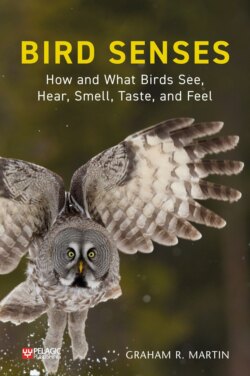Читать книгу Bird Senses - Graham R. Martin - Страница 45
На сайте Литреса книга снята с продажи.
Variation in image properties
ОглавлениеBy definition an image is never perfect. It is a simulacrum that always lacks some information about the world. The quality of the image, and hence the information that it contains, usually varies across the image surface. Image quality is usually closer to perfection along, or close to, the optic axis of the lens system. This is the line about which the optical elements of the system are arranged; in camera eyes it is the direction about which the cornea and lens are symmetrically aligned (Figure 3.2).
Moving away from the optic axis results in an image of progressively poorer quality. It is here, in the more peripheral parts of the image, where obvious distortions and aberrations occur. This is something that is readily apparent in simple hand lenses or in camera lenses at the cheaper end of the market. To correct for these peripheral distortions requires elaborations and refinements of the optical system, hence the high prices asked for camera lenses which maintain high quality across a broad section of the image.
The image produced by peripheral optics is often masked out in human-made cameras, and not presented for analysis by the film or photodiode array. However, peripheral optics cannot be ignored when trying to understand the visually guided behaviour of many vertebrate animals, including most birds. This is because in these species the eyes are placed on the side of the head and the visual field is often maximised, which requires use to be made of the entire image (Figure 3.3).
FIGURE 3.3 A diagrammatic section through the head of a bird showing a typical arrangement of eyes in the skull and how the visual fields of each eye combine. In all birds the eyes project laterally so that the axes of the eyes always diverge; no birds have forward-facing eyes. The fields of view of the two eyes are combined to give the total field of view, with a sector in front of the head where the two fields overlap to give a binocular field. A wide degree of variation in these basic arrangements is found in birds, resulting in different degrees of overlap, different width blind areas behind the head (though some birds have no such blind area). Just small variations in the width of the field of view of each eye, and of eye position in the skull, can result in large differences in visual fields between species. (Diagram by Nigel Hawtin, nigelhawtin.com.)
In some species, full use is made of an image from each eye that is more than 180 degrees wide. This gives the birds maximum visual coverage of the space around them. In many birds the width of the visual field behind the head is maximised in order to enhance the chances of detecting a predator, but this again can be achieved only by using peripheral optics (Figure 3.4).
FIGURE 3.4 Examples of the extremes of visual fields found in birds. In a Tawny Owl Strix aluco the axes of the eyes project laterally and forwards. The field of view of each eye is relatively narrow, and the eyes sit in the skull to give a relatively large degree of binocular overlap and an extensive blind region behind the head. In a Pink-eared Duck Malacorhynchus membranaceus the fields of each eye are extensive, a little over 180 degrees, and they project laterally to give the bird a small degree of binocular overlap both in front of and behind the head. This means that it sees all around its head in the horizontal plane. In fact the binocular region extends right above the head, and the duck has panoramic vision of the hemisphere around and above its head.
This lateral placement of the eyes in the skull is quite unlike the situation in ourselves. The optic axes of our eyes, and hence the best-quality optics, project directly forward. We do not try to look in the direction that we are travelling out of the sides of our eyes. This is, however, what all birds do to some extent. No bird species, not even owls, have eyes positioned to face directly forwards, and many birds look forward with the very periphery of their eyes’ optical systems. The consequence of this arrangement is that the best-quality optics in all birds projects laterally, away from the axis of the head, in some species markedly so. This has important consequences for understanding both the foraging behaviour and the role of vision in the control of locomotion in birds. It will be discussed in Chapter 5.
Another important property of the image is how much of the world is imaged at one instant. Does the imaging device have a wide or narrow field of view? This is important, since it determines from how much of the world around an animal’s head information can be gained at any instant.
